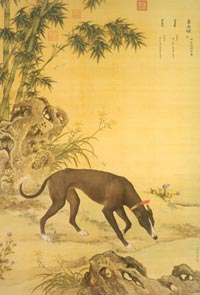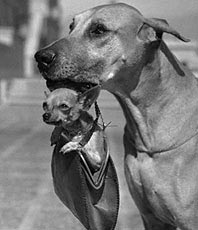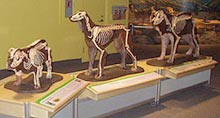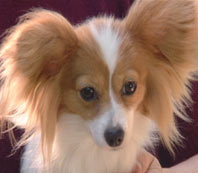| (insert your NIE or newspaper logo here) |
Weekly Online LessonOnline Lesson ArchiveGrade Level: 6-8
|
A Dog's Life
 Sunday,
January 29, marked the beginning of 2006—the
Year of the Dog—on the Chinese calendar's 12-year-cycle.
Sunday,
January 29, marked the beginning of 2006—the
Year of the Dog—on the Chinese calendar's 12-year-cycle.
Dogs have a long history in China. Centuries-old records show that the Chinese people developed certain dog breeds. One example is the Shar-Pei, which may have been developed as early as 200 B.C.
Following World War II, when China stabilized under communist law, the government struggled to feed and care for its human citizens and saw pets as luxury items. So, pets were strictly banned, city dogs were eliminated, and those that were left usually dropped in status—from family member to livestock to dinner entree. Breeds, like the Shar-Pei, were nearly wiped out to extinction.
In more recent years, however, a dog's fate in China has been improving. The pet ban has softened, and more and more Chinese can afford to care for pets themselves. Perhaps as a consequence of the dog's renewed status, the number of restaurants openly serving dog meat seems to be dwindling.
To honor the Year of the Dog, this week you'll get a look into the life of dogs—from their origins and basic biology, through selective breeding, and into how dogs have become intricate parts of everyday life for many people worldwide.
Canine Basics
 Start
out your study with Dogs: Wolf, Myth, Hero & Friend, at the Natural
History Museum of Los Angeles County.
Start
out your study with Dogs: Wolf, Myth, Hero & Friend, at the Natural
History Museum of Los Angeles County.
Let's begin with the dog's origins, to uncover mysteries about its Evolution and Diversity.
Click the Evolution link to explore the fossil record first. Read the main text, plus click on the small family tree image for a larger one to examine more closely. Also, review the definitions in the green box on the right-hand side of the page.
About how long ago did Canids distinctively appear in the fossil record? How closely are dogs related to other types of carnivores? What are the three main groups of dog species? On what continent did canines originate? Can you describe the difference between a species and a breed?
So, if the ancestry of all dogs can be traced back to the dire wolf, then how come we see so many distinctly different dogs? The answers to that question lie in Natural and Artificial Selection. Make sure to try the Activities for both types of selection, including a visit to the Dog Gone Perfect Laboratory.
How would you describe the different "motives" of Natural Selection and Artificial Selection in shaping the look and behaviors of different types of dogs? What characteristics match best for the different types of task a dog performs, like tracking a scent or sprinting?
 Most
people would agree that when dogs bark, howl, growl, or whine, they
seem to be saying something. But what?
Most
people would agree that when dogs bark, howl, growl, or whine, they
seem to be saying something. But what?
As you'll soon discover, Canine Communication includes both Body Language and Vocalizations.
Why do domestic dogs communicate somewhat differently than wild wolves?
Now, learn more about how a dog's Form and Function are related. For example, tune in to their Sense of Hearing, take a look at their Sense of Sight, pick up their Sense of Smell, and test out their Endurance.
How do dogs' senses compare with those of humans? Think about a local dog you know, and sketch his or her different sense organs. Now, match form with function—how would you describe the ability level of each sense? Explain your reasoning.
Lastly at the museum, find out about Dogs Helping People as Assistance Dogs and Therapy Dogs. How would you describe the different types of relationships fostered between dog and human through these services?
All About Breeds
 Test
your knowledge of dog breeding at the NOVA site on Dogs
and More Dogs, by playing the Dogs
Around the World interactive game.
Test
your knowledge of dog breeding at the NOVA site on Dogs
and More Dogs, by playing the Dogs
Around the World interactive game.
In what ways have the different breed traits matched the natural and human-made environments in which they were bred?
To learn even more about specific breeds, let's turn to the Discovery Channel's Dog Breed Directory.
First, browse the dog breeds by category, to get an idea of what kinds of breeds were bred for similar tasks. These include Herding, Hound, Nonsporting, Sporting, Terrier, Toy, and Working dogs.
How do the different breeds within each category vary by geographical origin? How do their dates of origin compare? Within each category of dogs, what are the common characteristics the breeds generally share? What dog breeds do you think would be your top three picks for a pet?
Now, go to the Dog Selector to answer questions and discover what breed of dog might best match you as an owner. Do any of the resulting selections match your top three picks?
If you have time, check out the details on some of the other breeds that came up based on your questionnaire choices. If you had to pick just one as a pet, which one would it be and why?
Newspaper Activities
Flip through issues of The Salt Lake Tribune and pick out photographs and articles that feature pets. Based on the images or stories, list physical traits, behavioral traits, or a "job" specific to that individual animal. For example, maybe a dog has large, pointy ears, or a cat serves as a therapy animal for seniors. Also list how any of those traits might be attractive to humans, like being a good guard dog or winning a contest. On a paper plate or sheet of paper, make a collage that represents each pet you find. As a class, compare each pet's traits, especially dogs to dogs or cats to cats. What exactly makes them different from each other? If possible, try to track down the probable breed of each animal. If an animal seems to be a mixed breed, hypothesize which breeds might be part of the mix based on the noted traits.
© Copyright 2006
Learners Online, Inc.
